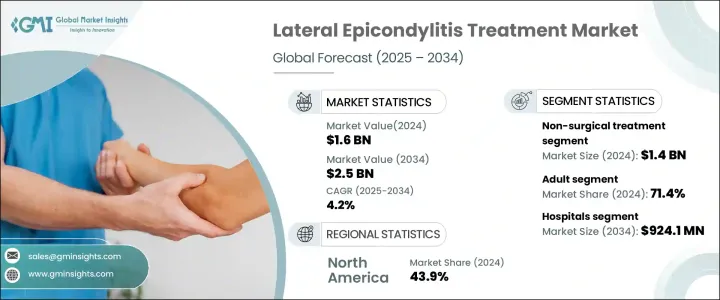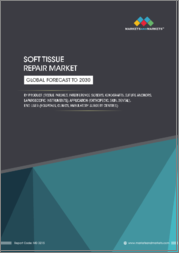
|
시장보고서
상품코드
1708208
상완골 외측상과염 치료 시장 기회, 성장 촉진요인, 산업 동향 분석, 예측(2025-2034년)Lateral Epicondylitis Treatment Market Opportunity, Growth Drivers, Industry Trend Analysis, and Forecast 2025 - 2034 |
||||||
세계의 상완골 외측상과염 치료 시장은 2024년에 16억 달러로 평가되며, 2025-2034년에 CAGR 4.2%로 성장할 것으로 예측됩니다.
일반적으로 테니스 엘보로 알려진 외측 상과염의 유병률 증가는 주로 스포츠 및 기타 활동 참여 증가에 기인합니다. 충격이 큰 스포츠나 반복적인 운동을 하는 사람들이 늘어남에 따라 이 질환에 걸릴 확률은 계속 증가하고 있습니다. 또한 조기 진단 및 치료 옵션에 대한 인식이 높아지면서 수술적 및 비수술적 개입에 대한 수요가 증가하고 있습니다. 또한 생물학적 요법이나 최소침습 수술과 같은 보다 안전하고 효과적인 치료법의 혁신도 눈에 띄게 발전하고 있습니다. 의료 서비스 프로바이더들이 환자 중심의 접근 방식을 우선시하고 예방 의료의 중요성을 강조함에 따라 물리치료 및 코르티코스테로이드 주사와 같은 비침습적 치료법에 대한 수요가 급증하여 전체 시장 성장에 기여하고 있습니다.

시장 확대의 또 다른 주요 요인은 외측상과염과 같은 근골격계 질환에 취약한 노년층 인구 증가입니다. 특히 신흥 경제국에서는 고령화가 진행되면서 수술에 비해 회복이 빠르고 위험이 낮은 비수술적 치료를 선택하는 경향이 증가하고 있습니다. 혈소판풍부혈장(PRP)과 줄기세포 치료와 같은 혁신적인 치료법은 통증 관리와 조직 재생에 유망한 결과를 가져와 인기를 끌고 있습니다. 이러한 발전은 기존 수술에 대한 효과적인 대안을 제공할 뿐만 아니라, 최소침습적 치료법을 선호하는 환자들 증가와 맞물려 시장 성장을 더욱 촉진하고 있습니다.
| 시장 범위 | |
|---|---|
| 시작연도 | 2024년 |
| 예측연도 | 2025-2034년 |
| 시작 금액 | 16억 달러 |
| 예상 금액 | 25억 달러 |
| CAGR | 4.2% |
상완골 외측 상과염 치료 시장은 크게 비수술적 치료와 수술적 치료로 나뉘며, 비수술적 치료가 2024년 비수술적 치료 분야의 매출은 14억 달러에 달할 것으로 예측됩니다. 물리치료, 약물 치료, 보조기, 충격파 치료와 같은 비수술적 치료는 통증 관리와 회복 촉진에 있으며, 높은 효과를 보이고 있습니다. 안전성이 높고, 다운타임이 짧고, 비용 효율적이기 때문에 점점 더 많은 환자들이 이러한 치료법을 선호하고 있습니다. 외측 상과염 치료에 대한 보존적 접근법을 찾는 사람들이 늘어남에 따라 비수술적 치료법에 대한 수요는 계속 증가할 것으로 예측됩니다.
연령대별로 시장을 분석하면 성인이 2024년 시장 점유율의 71.4%를 차지하며 압도적으로 많았습니다. 성인은 일상 업무나 여가 활동에서 반복되는 동작으로 인해 외측 상과염에 걸리기 쉽습니다. 스포츠 경쟁 증가와 피트니스 동향은 이 질환의 유병률을 더욱 증가시켜 효과적인 치료 옵션의 필요성을 더욱 높이고 있습니다. 또한 통증 관리 솔루션에 대한 수요로 인해 비수술적 치료법이 지속적으로 발전하여 환자가 안전하고 신뢰할 수 있는 치료 옵션을 이용할 수 있도록 하고 있습니다.
미국의 상완골 외측 상과염 치료 시장은 2024년 6억 5,600만 달러 시장을 창출하며 세계 시장에서 주요 기업으로 자리매김했습니다. 중국에서는 스포츠 및 육체노동과 같은 신체활동이 활발해지면서 외측상과염 환자 수가 증가하고 있습니다. 부신피질 스테로이드 주사와 국소 치료 등 효과적인 통증 관리 솔루션 제공에 중점을 두고 미국 시장은 지속적으로 성장하고 있습니다. 생물학적 치료와 재생의료 분야의 지속적인 연구개발 노력은 전 세계 상완골 외측 상과염 치료 분야에서 미국의 우위를 더욱 강화시키고 있습니다.
목차
제1장 조사 방법과 조사 범위
제2장 개요
제3장 업계 인사이트
- 에코시스템 분석
- 업계에 대한 영향요인
- 촉진요인
- 외측상과염과 스포츠 관련 상해의 증가
- 저침습수술에 대한 선호도의 증가
- 치료 방법의 진보
- 업계의 잠재적 리스크 & 과제
- 높은 치료비
- 대체요법의 이용 가능성
- 촉진요인
- 성장 가능성 분석
- 규제 상황
- Porter의 산업 분석
- PESTEL 분석
제4장 경쟁 구도
- 서론
- 기업 매트릭스 분석
- 기업 점유율 분석
- 주요 시장 기업의 경쟁 분석
- 경쟁 포지셔닝 매트릭스
- 전략 대시보드
제5장 시장 추산·예측 : 치료 유형별, 2021-2034년
- 주요 동향
- 비외과수술 치료
- 약물 요법
- 물리 치료
- 장구와 브레이스
- 기타 비외과수술 치료
- 외과수술 치료
- 관절경 수술
- 개복 수술
- 기타 외과수술 치료
제6장 시장 추산·예측 : 연령층별, 2021-2034년
- 주요 동향
- 소아
- 성인
- 노년
제7장 시장 추산·예측 : 최종 용도별, 2021-2034년
- 주요 동향
- 병원
- 외래 수술 센터
- 정형외과 클리닉
- 재택 의료
- 기타 최종 용도
제8장 시장 추산·예측 : 지역별, 2021-2034년
- 주요 동향
- 북미
- 미국
- 캐나다
- 유럽
- 독일
- 영국
- 프랑스
- 스페인
- 이탈리아
- 네덜란드
- 아시아태평양
- 중국
- 인도
- 일본
- 호주
- 한국
- 라틴아메리카
- 브라질
- 멕시코
- 아르헨티나
- 중동 및 아프리카
- 남아프리카공화국
- 사우디아라비아
- 아랍에미리트
제9장 기업 개요
- 3M Company
- BTL
- DJO Global(Enovis)
- Folsom Orthopaedics &Sports Medicine
- GlaxoSmithKline
- MedStar Health
- Merck &Co
- Novartis
- Ossur Corporate
- Pfizer
- Pharmascience
- ReLiva Physiotherapy &Rehab
- Scandinavian Physiotherapy Center
- Zimmer Biomet
The Global Lateral Epicondylitis Treatment Market was valued at USD 1.6 billion in 2024 and is projected to grow at a CAGR of 4.2% between 2025 and 2034. The growing prevalence of lateral epicondylitis, commonly known as tennis elbow, is primarily driven by increasing participation in sports and other physical activities. As more individuals engage in high-impact sports and repetitive motion exercises, the likelihood of developing this condition continues to rise. Additionally, heightened awareness about early diagnosis and treatment options has led to a higher demand for both surgical and non-surgical interventions. The market has also witnessed significant innovation in treatment modalities, including biological therapies and minimally invasive procedures, which offer safer and more effective solutions for managing the condition. As healthcare providers prioritize patient-centric approaches and emphasize the importance of preventive care, the demand for non-invasive therapies, such as physical therapy and corticosteroid injections, has surged, contributing to the overall market growth.

Another major factor propelling market expansion is the rising geriatric population, which is more susceptible to musculoskeletal conditions, such as lateral epicondylitis. The aging demographic, particularly in developed economies, is increasingly opting for non-surgical treatments that offer faster recovery times and lower risks compared to surgical procedures. Innovative therapies such as platelet-rich plasma (PRP) and stem cell treatments are gaining traction, offering promising outcomes in pain management and tissue regeneration. These advancements not only provide effective alternatives to traditional surgery but also align with the growing patient preference for minimally invasive options, further driving market growth.
| Market Scope | |
|---|---|
| Start Year | 2024 |
| Forecast Year | 2025-2034 |
| Start Value | $1.6 Billion |
| Forecast Value | $2.5 Billion |
| CAGR | 4.2% |
The lateral epicondylitis treatment market is broadly segmented into non-surgical and surgical treatment categories, with non-surgical options leading the way. In 2024, the non-surgical treatment segment generated USD 1.4 billion in revenue. Non-surgical therapies, including physical therapy, medications, braces, and shockwave therapy, have demonstrated high efficacy in managing pain and accelerating recovery. Patients increasingly prefer these treatments due to their safety, reduced downtime, and cost-effectiveness. As more individuals seek conservative approaches to manage lateral epicondylitis, the demand for non-surgical therapies is expected to continue its upward trajectory.
When analyzing the market by age group, adults dominated the landscape, accounting for 71.4% of the market share in 2024. Adults are more prone to developing lateral epicondylitis due to repetitive movements involved in their daily work or recreational activities. The growing number of sports competitions and fitness trends has further increased the prevalence of this condition, driving the need for effective treatment options. Furthermore, the demand for pain management solutions has led to continuous advancements in non-surgical methods, ensuring that patients have access to safe and reliable treatment options.
The U.S. lateral epicondylitis treatment market generated USD 656 million in 2024, securing its position as a key player in the global landscape. The high incidence of physical activity, including sports and manual labor, has led to an increased number of lateral epicondylitis cases in the country. With a strong emphasis on providing effective pain management solutions, including corticosteroid injections and topical treatments, the U.S. market continues to thrive. Ongoing research and development efforts in biological therapies and regenerative medicine have further strengthened the country's dominance in the global lateral epicondylitis treatment sector.
Table of Contents
Chapter 1 Methodology and Scope
- 1.1 Market scope and definition
- 1.2 Research design
- 1.2.1 Research approach
- 1.2.2 Data collection methods
- 1.3 Base estimates and calculations
- 1.3.1 Base year calculation
- 1.3.2 Key trends for market estimation
- 1.4 Forecast model
- 1.5 Primary research and validation
- 1.5.1 Primary sources
- 1.5.2 Data mining sources
Chapter 2 Executive Summary
- 2.1 Industry 3600 synopsis
Chapter 3 Industry Insights
- 3.1 Industry ecosystem analysis
- 3.2 Industry impact forces
- 3.2.1 Growth drivers
- 3.2.1.1 Increasing incidence of lateral epicondylitis and sports-related injuries
- 3.2.1.2 Growing preference for minimally invasive procedures
- 3.2.1.3 Advancement in treatment modalities
- 3.2.2 Industry pitfalls and challenges
- 3.2.2.1 High treatment cost
- 3.2.2.2 Availability of alternative therapies
- 3.2.1 Growth drivers
- 3.3 Growth potential analysis
- 3.4 Regulatory landscape
- 3.5 Porter's analysis
- 3.6 PESTEL analysis
Chapter 4 Competitive Landscape, 2024
- 4.1 Introduction
- 4.2 Company matrix analysis
- 4.3 Company market share analysis
- 4.4 Competitive analysis of major market players
- 4.5 Competitive positioning matrix
- 4.6 Strategy dashboard
Chapter 5 Market Estimates and Forecast, By Treatment Type, 2021 – 2034 ($ Mn)
- 5.1 Key trends
- 5.2 Non-surgical treatment
- 5.2.1 Medications
- 5.2.2 Physical therapy
- 5.2.3 Orthotics and braces
- 5.2.4 Other non-surgical treatments
- 5.3 Surgical treatment
- 5.3.1 Arthroscopic surgery
- 5.3.2 Open surgery
- 5.3.3 Other surgical treatments
Chapter 6 Market Estimates and Forecast, By Age Group, 2021 – 2034 ($ Mn)
- 6.1 Key trends
- 6.2 Pediatric
- 6.3 Adult
- 6.4 Geriatric
Chapter 7 Market Estimates and Forecast, By End Use, 2021 – 2034 ($ Mn)
- 7.1 Key trends
- 7.2 Hospitals
- 7.3 Ambulatory surgical centers
- 7.4 Orthopedic clinics
- 7.5 Homecare settings
- 7.6 Other end use
Chapter 8 Market Estimates and Forecast, By Region, 2021 – 2034 ($ Mn)
- 8.1 Key trends
- 8.2 North America
- 8.2.1 U.S.
- 8.2.2 Canada
- 8.3 Europe
- 8.3.1 Germany
- 8.3.2 UK
- 8.3.3 France
- 8.3.4 Spain
- 8.3.5 Italy
- 8.3.6 Netherlands
- 8.4 Asia Pacific
- 8.4.1 China
- 8.4.2 India
- 8.4.3 Japan
- 8.4.4 Australia
- 8.4.5 South Korea
- 8.5 Latin America
- 8.5.1 Brazil
- 8.5.2 Mexico
- 8.5.3 Argentina
- 8.6 Middle East and Africa
- 8.6.1 South Africa
- 8.6.2 Saudi Arabia
- 8.6.3 UAE
Chapter 9 Company Profiles
- 9.1 3M Company
- 9.2 BTL
- 9.3 DJO Global (Enovis)
- 9.4 Folsom Orthopaedics & Sports Medicine
- 9.5 GlaxoSmithKline
- 9.6 MedStar Health
- 9.7 Merck & Co
- 9.8 Novartis
- 9.9 Ossur Corporate
- 9.10 Pfizer
- 9.11 Pharmascience
- 9.12 ReLiva Physiotherapy & Rehab
- 9.13 Scandinavian Physiotherapy Center
- 9.14 Zimmer Biomet



















